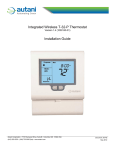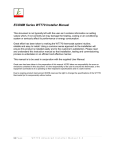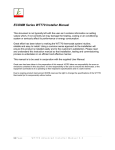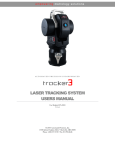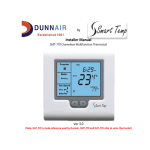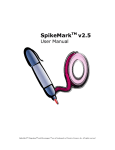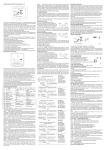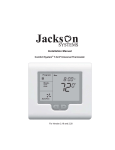Download Heating Green HG-122 Installation Manual
Transcript
Installation Manual Comfort System HG-122 Universal Thermostat TM O Version 3.0 INTRODUCTION This manual should not be left with the owner as it contains installer setup functions which, if not correctly set, may cause damage to the HVAC equipment or seriously affect performance. The HG-122 thermostat is intuitive, reliable and easy to install. Using a common sense approach to the installation will ensure this product is installed properly and to the customer’s satisfaction. Please take time to read and understand this manual so that installation and testing is performed in an efficient manner. This manual is to be used in conjunction with the supplied User Manual. Although great care has been taken in the preparation of this manual, Heating Green takes no responsibility for errors or omissions contained herein. It is the responsibility of the installer to ensure that this thermostat and the equipment connected to it operate in a safe and efficient manner. Due to ongoing product improvements, Heating Green reserves the right to change the specifications of the HG-122 thermostat or its components without notice. All rights reserved. © Heating Green 2010. Intellectual rights apply. 1 GETTING STARTED As with any HVAC project, careful installation is the key to a successful outcome. Time taken during the installation process will be rewarded with fewer call-backs. The steps required to install the HG-122 thermostat are as follows: 1. Read and understand this Installation Manual and Operation Manual. 2. Mount the HG-122. 3. Set the 8 system switches to match the equipment application. 4. Wire the optional remote temperature sensor(s) or devices. 5. Power the thermostat. 6. Set the Advanced Installer Setup options. 7. Program and setup the HG-122 thermostat. (Refer to the Operation Manual for instructions) 8. Test heating, cooling and other functions. INSTALLING THE THERMOSTAT DISASSEMBLY Insert a small coin (dime) in the release slot located on the bottom of the thermostat. Gently twist the coin to release the thermostat from the subbase. Avoid twisting the case as this may stress the LCD or bend the terminal connector pins. (Figure 1) THERMOSTAT LOCATION The HG-122 should be installed in a location that represents the ambient space temperature. Do not install the thermostat in an area where drafts are present, near the floor, behind doors or on an external wall. Avoid placing the thermostat in areas where the air movement is limited, affected by direct sunlight or other areas not typical of the temperature in the space. MOUNTING THE SUBBASE When mounting the HG-122, be aware that drafts may travel down wall cavities and enter the back of the thermostat through the control wire hole in the wall. It is important to seal the hole to prevent any drafts that might affect the internal temperature FIGURE 1 2 INSTALLING THE THERMOSTAT Pull the control wires through the large opening in the thermostat subbase. Next, level and mount the subbase on the wall using the supplied anchors and screws. Do not over tighten the mounting screws as the subbase may warp causing the improper seating of the thermostat connecting pins to the terminal blocks. MOUNTING HOLES Use a properly sized screwdriver and land each wire to its dedicated terminal. Do not over tighten the terminal screws. Check to ensure that all wires are landed correctly and dressed properly to prevent any shorts (refer to the “Typical System Wiring Diagrams” in the manual). (Figure 2) FIGURE 2 Refer to Typical System Wiring Diagrams in this manual. TERMINAL DESIGNATIONS Based on the HG-122 slide switch configurations, some terminals have multiple output functions. (Figure 3) FACTORY JUMPER W1 W2 Y2 O/B Y1 G R Power Coms Aux 24 24C B A T T FIGURE 3 TERMINAL W2 Y2 W1 O/B Y1 G R 24 24V B A T T 3 TERMINAL DESIGNATION CHART DESIGNATION Second Stage Heating or Auxiliary Heat Second Stage Compressor First Stage Heating Reversing Valve First Stage Compressor Fan Relay 24 Volt Hot (Jumpered to ‘24’) 24 Volt Hot (Jumpered to ‘R’) 24 Volt Common Modbus Communications Modbus Communications Auxiliary Input Terminal Auxiliary Input Terminal SPECIAL INSTRUCTIONS FOR DUAL FUEL APPLICATIONS When the HG-122 is used with dual fuel systems, an outdoor sensor is recommended for balance point control (Model HG-122-S1). The sensor is wired to the TT terminals on the thermostat. In the Advanced Installer Settings, set TT = OA. This configures the thermostat to receive the outdoor temperature information. High and low balance point settings are set in the Advanced Installer Settings. HB = OFF is the factory default high balance point setting and LB = OFF is the factory default low balance point setting. High balance point is adjustable from OFF to 32° F - 122° F and low balance point is adjustable from OFF to 14° F - 77° F. When the outdoor temperature rises above the high balance point setting, only first stage heat pump will be allowed to energize. When the outdoor temperature falls below the low balance point setting, only the auxiliary heat will be energized and the heat pump will be locked out. Typical settings might be 30° F Low Balance Point and 55° F High Balance Point. High and low balance point control can also be used in conventional heat pump applications. The high balance point must be greater than the low balance point and there should be at least a 5° F spread between the two. ACTIVATING THE BATTERY The HG-122 contains a 3 volt Lithium cell battery that maintains the time of day in the event of a power failure. To activate the battery, carefully remove the white tab. (Figure 4) REMOVE TAB ON 12345678 ...... ...... FIGURE 4 SETTING THE SYSTEM SWITCHES The HG-122 contains a set of eight system switches located on the thermostat printed circuit board. The switches are used to match the thermostat with the specific type of HVAC system and user preferences. Refer to the system switch functions to properly configure the thermostat. (Figure 5) ON 12345678 ...... ...... FIGURE 5 4 SYSTEM SWITCH FUNCTIONS Sw1 - Equipment Type Switch 1 sets the equipment type. For heat / cool equipment, set the switch to the OFF position (factory default). For heat pump equipment, set the switch to the ON position. Sw2 - Equipment Stages Switch 2 sets the equipment stages. For single stage equipment, set the switch to the OFF position (factory default). For multi-stage equipment, set the switch to the ON position. Sw3 - Heat Pump Type Switch 3 is used to select conventional heat pump or dual fuel operation. For conventional heat pump, set the switch to the OFF position (factory default). For dual fuel operation, set the switch to the ON position. Sw4 - Reversing Valve Switch 4 is used to select the heat pump reversing valve. For ‘O’ reversing valve (energize in cooling), set the switch to the OFF position (factory default). For ‘B’ reversing valve (energize in heating), set the switch to the ON position. Sw5 - Fan Switch 5 is used to configure the fan operation. For gas systems, set the switch to OFF (factory default). For heat pump and electric systems, set the switch to ON position. Sw6 - Thermostat Mode Switch 6 is used to set the thermostat mode. For non-programmable, set the switch to the OFF position (factory default). For programmable, set the switch to the ON position. Sw7 - Schedules OFF = 4 schedules per day (factory default). ON = 2 schedules per day. Sw8 - Compressor Delay OFF = 4 minute short cycle protection (factory default). ON = Disabled. FACTORY DEFAULT SETTINGS SWITCH 1 - Equipment Type 2 - Equipment tages 3 - Heat Pump Type 4 - Reversing Valve 5 - Fan 6 - Thermostat Mode 7 - Schedules 8 - Compressor Delay 5 ON/OFF OFF OFF OFF OFF OFF OFF OFF OFF FUNCTION Heat / Cool Single Stage Conventional Heat Pump ‘O’ Reversing Valve Equipment Controls Fan Non-programmable 4 Schedules per Day 4 Minute Short Cycle Protection Enabled TYPICAL SYSTEM WIRING DIAGRAMS HEAT OR COOL ONLY W2 Y2 W1 O/B G Y1 HEAT 1 RELAY 24 R 24C FAN 1 RELAY B A MODBUS COMP 1 RELAY T T TT TERMINALS 24 V LINE Switch Settings Sw1 = OFF Sw2 = OFF Sw3 = OFF Sw4 = OFF Sw5 = Equipment Type (Heat/Cool) (Single Stage) (Not Applicable) (Not Applicable) (OFF = Equipment Controls Fan - Gas) (ON = Thermostat Control Fan - Electric) (OFF = Non-Programmable) (ON = Programmable) (OFF = 4 Schedules per Day) (ON = 2 Schedules per Day) (OFF = Cooling Only) (ON = Heating Only) Sw6 = User Preference Sw7 = User Preference Sw8 = Application Type In Advanced Installer Menu Set FN=H for Heat Only or FN=C for Cool Only 1 HEAT / 1 COOL W2 Y2 W1 O/B G Y1 HEAT 1 RELAY FAN 1 RELAY COMP 1 RELAY R 24 24C B A MODBUS 24 V T T TT TERMINALS LINE Switch Settings Sw1 = OFF Sw2 = OFF Sw3 = OFF Sw4 = OFF Sw5 = OFF Sw6 = User Preference Sw7 = User Preference Sw8 = OFF (Heat/Cool) (Single Stage) (Not Applicable) (Not Applicable) (Equipment Controls Fan) (OFF = Non-Programmable) (ON = Programmable) (OFF = 4 Schedules per Day) (ON = 2 Schedules per Day) (4 Minute Short Cycle Protection) 6 TYPICAL SYSTEM WIRING DIAGRAMS 2 HEAT / 2 COOL Y2 G2 W2 G3 W1 O/B HEAT 2 RELAY G1 Y1 HEAT 1 RELAY COMP 2 RELAY R 24 24C B FAN 1 RELAY A MODBUS COMP 1 RELAY T T TT TERMINALS LINE 24 V Switch Settings Sw1 = OFF Sw2 = ON Sw3 = OFF Sw4 = OFF Sw5 = OFF Sw6 = User Preference (Heat/Cool) (Multi-stage) (Not Applicable) (Not Applicable) (Equipment Controls Fan) (OFF = Non-Programmable) (ON = Programmable) (OFF = 4 Schedules per Day) (ON = 2 Schedules per Day) (4 Minute Short Cycle Protection) Sw7 = User Preference Sw8 = OFF 2 HEAT / 1 COOL HEAT PUMP W2 AUX HEAT Y2 W1 O/B G Y1 REV VALVE FAN 1 RELAY COMP 1 RELAY R 24 24C B A MODBUS 24 V T T TT TERMINALS LINE Switch Settings Sw1 = ON Sw2 = OFF Sw3 = OFF Sw4 = Reversing Valve Sw5 = ON Sw6 = User Preference Sw7 = User Preference Sw8 = OFF (Heat Pump) (Single Stage) (Conventional Heat Pump) (OFF = ‘O’) (ON = ‘B’) (Thermostat Controls Fan) (OFF = Non-Programmable) (ON = Programmable) (OFF = 4 Schedules per Day) (ON = 2 Schedules per Day) (4 Minute Short Cycle Protection) IMPORTANT: If an outdoor sensor is used and High or Low Balance Point control is required, set HB and LB in the Advanced Installer menu. 7 TYPICAL SYSTEM WIRING DIAGRAMS 3 HEAT / 2 COOL HEAT PUMP W1 O/B Y2 W2 AUX HEAT G Y1 REV VALVE COMP 2 RELAY R 24 24C B FAN 1 RELAY A MODBUS COMP 1 RELAY T T TT TERMINALS LINE 24 V Switch Settings Sw1 = ON Sw2 = ON Sw3 = OFF Sw4 = Reversing Valve (Heat Pump) (Multi-stage) (Conventional Heat Pump) (OFF = ‘O’)) (ON = ‘B’) (OFF = Non-Programmable) (ON = Programmable) (OFF = 4 Schedules per Day) (ON = 2 Schedules per Day) (4 Minute Short Cycle Protection) Sw5 = ON Sw7 = User Preference Sw8 = OFF IMPORTANT: If an outdoor sensor is used and High or Low Balance Point control is required, set HB and LB in the Advanced Installer menu. 2 HEAT / 1 COOL DUAL FUEL W2 FOSSIL FUEL Y2 W1 O/B G Y1 REV VALVE FAN 1 RELAY COMP 1 RELAY R 24 24C B A MODBUS 24 V T T TT TERMINALS LINE Switch Settings Sw1 = ON Sw2 = OFF Sw3 = ON Sw4 = Reversing Valve Sw5 = ON Sw6 = User Preference Sw7 = User Preference Sw8 = OFF (Heat Pump) (Single Stage) (Dual Fuel) (OFF = ‘O’) (ON = ‘B’) (Thermostat Controls Fan) (OFF = Non-Programmable) (ON = Programmable) (OFF = 4 Schedules per Day) (ON = 2 Schedules per Day) (4 Minute Short Cycle Protection) IMPORTANT: An outdoor sensor is used for High or Low Balance Point. Set HB and LB in the Advanced Installer menu. 8 TYPICAL SYSTEM WIRING DIAGRAMS 3 HEAT / 2 COOL DUAL FUEL W1 O/B Y2 W2 FOSSIL FUEL REV VALVE COMP 2 RELAY G Y1 R 24 24C FAN 1 RELAY COMP 1 RELAY B A MODBUS T T TT TERMINALS 24 V LINE Switch Settings Sw1 = ON Sw2 = ON Sw3 = ON Sw4 = Reversing Valve Sw5 = ON Sw6 = User Preference Sw7 = User Preference Sw8 = OFF (Heat Pump) (Multi-stage) (Dual Fuel) (OFF = ‘O’) (ON = ‘B’) (Thermostat Controls Fan) (OFF = Non-Programmable) (ON = Programmable) (OFF = 4 Schedules per Day) (ON = 2 Schedules per Day) (4 Minute Short Cycle Protection) IMPORTANT: If an outdoor sensor is used and High or Low Balance Point control is required, set HB and LB in the Advanced Installer menu. ENTERING THE ADVANCED INSTALLER SETTINGS MENU The HG-122 contains factory defaults for all Advanced Installer Settings. Depending upon the user and equipment application, some settings may need to be changed. To enter the Advanced Installer Settings menu, push the O/RIDE button once, then hold it down (15 seconds) until the LCD displays LC which is the first menu item. You can move forward or backwards through the menu by pressing the O/RIDE or PROG buttons. ADVANCED INSTALLER SETTINGS MENU Symbol LC Default 00 Keypad Lockout Programmable Mode (Sw6=ON) LC=00 - All buttons are unlocked LC=01 - All buttons are locked except ( ) ( ) buttons LC=02 - All buttons are locked LC LC=00 - All buttons are unlocked LC=02 - All buttons locked except ( ) ( ) buttons LC=03 - PROG button is locked LC=04 - All buttons are locked 00 Non-programmable Mode (Sw6=OFF) 9 Function ADVANCED INSTALLER SETTINGS MENU Symbol Default Function HL 90 Maximum Heating Setpoint Limit Adjustable from 41° F - 120° F CL 50 Minimum Cooling Setpoint Limit Adjustable from 43° F - 122° CF F Temperature Display CF=F - Fahrenheit CF=C - Celsius C1 0.0 Internal Sensor Calibration Adjustable +/- 9° F in 0.2° F increments TC 12 Time Format TC=12 - 12 Hour Time TC=24 - Military Time TC=00 - No time displayed in non-programmable mode AH 2 Temporary Hold Time for Programmable Mode 0.5 - 12 hours or OFF which holds to next event FO 0 Advanced Fan Function 4 schedules per day = constant fan in 1, 2, 3 and auto fan in 4 2 schedules per day = constant fan in Day and auto fan in Night FP 0 FN --- FO=0 - No advanced fan function FO=2 - Constant fan during occupied mode. (Fan must be set to ON for this function to work) Fan Purge Adjustable from 0 - 5 minutes after any call Mode FN= - - - Manual Changeover FN=A - Auto Changeover FN=C - Cooling Only FN=H - Heating Only TT OFF Remote Sensor TT=OFF - No Remote Sensor TT=OA - Outdoor Sensor TT=RS - Remote Indoor Sensor TT=AU - Indoor Remote Sensor Averaging with Internal Sensor OS 1 Adaptive Recovery (Programmable Mode) OS=0 - OFF OS=1 - ON HB OFF High Balance Point Adjustable from OFF to 32° F - 122° F LB OFF Low Balance Point Adjustable from OFF to 14° F - 77° F AD 1 Modbus Address Adjustable from 1 - 99 10 ADVANCED INSTALLER SETTINGS MENU Symbol BD Default 19.2 Function Baud Rate BD=4.8 BD=9.6 BD=19.2 CD 0 Commissioning Mode CD=0 - OFF CD=1 - All internal time delays are overridden This function must be reset to CD=0 to prevent equipment from short cycling TS 0 Factory Test TS=0 - Test Mode OFF Do not change this function without reading the Factory Test Mode instructions on Page 27 TT TERMINAL FUNCTIONS The ‘T’ and ‘T’ terminals on the HG-122 are used for wiring either an indoor or an outdoor remote sensor. Each configuration requires setup in the Advanced Installer menu. REMOTE SENSORS There are two type of remote sensors. The HG-122-S1 is a single sensor that can be used indoors or outdoors. The HG-122-S2 contains two sensors. A combination of both sensors can be used for indoor temperature averaging to simplify wiring. OUTDOOR SENSOR WIRING When the HG-122-S1 is used as an outdoor sensor, the HG-122 will display the outside air temperature. In the Advanced Installer menu, TT=OA. The outdoor sensor can also be used for high and low balance point control in dual fuel systems and conventional heat pumps. Use separate 18-2 thermostat cable when wiring the sensor to the thermostat. If the outdoor sensor fails, or is not wired properly, two dashes will appear on the LCD where the outside temperature would normally be displayed. (Figure 6) 11 W2 Y2 W1 O/B Y1 G R 24 T-32-S1 SENSOR FIGURE 6 24C B A T T TT TERMINAL FUNCTIONS INDOOR SENSOR WIRING W2 G3 When the HG-122-S1 is used as an indoor sensor, the HG-122 can be configured to allow only the remote sensor to control the temperature (TT=RS) or both the remote and onboard sensor can be used for temperature averaging (TT=AV). An optional in-line switch can also be used with the remote sensor to change the temperature sensing location from remote to onboard sensor. The Advanced Installer menu setting must be TT=RS to use this feature. (Figure 7) Y2 G2 W1 O/B Y1 G1 R 24 24C B A T T HG-122-S1 SENSOR OPTIONAL SWITCH FIGURE 7 W2 G3 Y2 G2 W1 O/B Y1 HG-122-S2 SENSOR G1 R 24 24C B A T T USING MULTIPLE SENSORS FOR TEMPERATURE AVERAGING HG-122-S2 SENSOR Multiple sensors can be connected to the ‘T’ and ‘T’ terminals if temperature averaging is required with or without the sensor in the thermostat. The total value of remote sensors wired in series/parallel must equal 10kΩ @ 77º F. The onboard sensor is not part of the equation. Figure 8 shows (2) HG-122-S2 sensors used for averaging. FIGURE 8 12 TESTING Testing ensures that the thermostat and the HVAC equipment operate properly. Follow the detailed testing steps and refer to the Troubleshooting Guide in this manual if any problems are encountered. When the HG-122 is powered, the LCD will briefly show all available LCD icons, software version, then display the time and operating mode, etc. Program hold active Current running program Day Start Stop Clock System mode Fan status Set or room temperature System or thermostat fault TIMER Modbus Keyboard communications or control active limit is locked Outside air temperature Override timer activated Commissioning mode TESTING The HG-122 incorporates a number of time delays which can be disabled during testing by setting CD=1 in the Advanced Installer menu. After exiting the menu, a wrench icon will flash on the LCD. This is to remind you that once testing is completed, the time delays need to be re-initiated by setting CD=0 in the Advanced Installer menu. TESTING FAN OPERATION Pres the MODE button until the word OFF is displayed on the LCD. Press the FAN button and the word Fan On will appear. After a brief moment, the internal fan relay will energize and the fan icon will appear and rotate. TESTING CONVENTIONAL HEATING AND COOLING OPERATION Press the MODE button until Mode Heat appears on the LCD. Use the ( ) button and raise the setpoint a few degrees above the space temperature. The heating relay will energize and the word Heat will change to Heating. If the thermostat has been configured for multi-stage operation, raise the setpoint further and the second stage heating relay will energize. A period ( . ) will be displayed after the word Mode. 13 TESTING Press the MODE button until Mode Cool appears on the LCD. Use the ( ) button and lower the setpoint a few degrees below the space temperature. The cooling and fan relays will energize and the word Cool will change to Cooling. If the thermostat has been configured for multi-stage operation, lower the setpoint further and the second stage cooling relay will energize. A period ( . ) will be displayed after the word Mode. TESTING HEAT PUMP OPERATION When the HG-122 is configured for heat pump operation, testing is the same as for a conventional heating and cooling system with the exception that the fan relay is energized on a call for both heating and cooling. Emergency Heat mode is only active when the thermostat MODE button is set to emergency heat. E. Heat will be displayed on the LCD. When the W2 relay is energized E. Heating will be displayed on the LCD. When the thermostat is in the heat pump mode, the reversing valve is energized with a cooling call ‘O’ or heating call ‘B’, it will remain energized until there is an opposite call. If after 30 minutes there is no call, the reversing valve will de-energize. RESETTING THE TIME DELAYS After testing the thermostat, change CD=1 to CD=0 in the Advanced Installer menu. This will be confirmed when the flashing wrench icon no longer appears on the LCD. FACTORY TEST MODE The HG-122 contains a simple factory Test Mode that can confirm relay outputs, slide switch configuration along with a factory default reset. TS=0 - Factory Test Mode is OFF TS=1 - Displays system configuration code based on slide switch settings (for factory use only). TS=2 - Cycles each relay on and off in an endless loop. Equipment should be disabled when performing this test. TS=3 - Resets software to factory defaults. Press Fan button to initiate. ADAPTIVE RECOVERY Adaptive Recovery is only available in programmable mode (Sw6=ON and OS=1). The Adaptive Recovery function of the HG-122 permits the user to program a time that a desired set temperature is required. The thermostat then calculates the most energy efficient time to bring on the equipment to reach the setpoint at the designated time. This calculation involves a complex control algorithm that compares the space temperature deviation from setpoint and rate of recovery history. “RECO” flashes on the LCD when Adaptive Recovery is active. 14 BASIC TROUBLESHOOTING SYMPTOM POSSIBLE FAULT AND REMEDY No LCD display Remove thermostat from subbase and check for 24 Volts across ‘24’ and ‘24C’. Make sure the factory jumper is between ‘R’ and ‘24’. If no voltage, check voltage at HVAC system terminals ‘R’ and ‘C’. If no voltage, fault is equipment related. If voltage, fault could be in wiring. Thermostat can not be set for auto changeover In the Advanced Installer menu, set FN=A for auto changeover. FN=C is for cooling only. FN=H is for heating only. FN= . . . is for manual heat / cool changeover. Temperature display inaccurate. Air from the wall cavity may be leaking into the rear of the thermostat. Seal holes in the wall to prevent air infiltration. The temperature sensor might be folded back inside the thermostat and is not being exposed to the room temperature. Carefully move the sensor head so that it is just behind the sensor opening in the case. External influence from appliances, lighting or drafts may be affecting temperature accuracy. Move lamps or other sources of abnormal temperature influence away from the thermostat. Wrench icon flashes on LCD This is not a fault. Commissioning mode is enabled and time delays are overridden. Change CD=1 to CD=0 in the Advanced Installer menu. Outdoor temperature does not display. Dashes (- - -) appear on the LCD. Check wiring to outdoor sensor. Make sure that TT=OA in the Advanced Installer menu. Heating or Cooling is flashing This is not a fault. The thermostat is in the short cycle protection mode. This prevents the equipment from running for 4 minutes after the thermostat calls. Lock icon flashes when trying to set a higher heating or lower cooling temperature. This is not a fault. HL and CL restrict the heating and cooling setpoints. The limit values can be changed in the Advanced Installer menu. Thermostat displays wrong temperature The HG-122 can display in either Fahrenheit or Celsius. Change CF=C or F in the Advanced Installer menu. The fan continues to run after a heating or cooling call is satisfied. The thermostat is set to Fan On. Set thermostat to Auto Fan. The fan purge mode is set to run the fan for a fixed period of time after the equipment shuts off. Change the FP value in the Advanced Installer menu. Some buttons on the thermostat do not function. Lock values have been set. Refer to LC settings in the Advanced Installer menu. Thermostat clock does not keep proper time. Make sure that the plastic tab on the internal fitted battery is removed so that the battery is operational. 15 REMOTE SENSOR INSTALLATION INSTRUCTIONS The HG-122 can use an indoor remote sensor or multiple sensors for temperature averaging, or as an outdoor sensor for temperature display or a control function depending upon the thermostat configuration. INDOOR SENSOR INSTALLATION Locate the sensor in the same manner as a thermostat. Mount the sensor 18” away from any outside wall. Do not install the sensor behind doors, in corners or other dead air spaces. Keep the sensor away from direct air flow, supply registers or near sources of heat such as lamps and appliances. The maximum wire length from the sensor to the thermostat is 300 feet. Use a separate 18-2 thermostat cable for sensor wiring. Prior to wiring the sensor to the thermostat, use an ohm-meter or multimeter to measure the resistance of the sensor. Measure at the end of the wires that will connect to the thermostat. Confirm the resistance value (within 5%) to the temperature where the sensor is mounted. Disconnect power to the thermostat when wiring the sensor to the ‘T’ and ‘T’ terminals. Strip only as much insulation off of the wires as necessary to provide a good contact with the terminals. The sensor is not polarity specific so either sensor lead may be connected to either terminal on the thermostat. OUTDOOR SENSOR INSTALLATION Mount the sensor on a vertical exterior surface below an overhang. Choose a location protected from direct sunlight and exposure to excessive moisture. Follow the same wiring and test procedures as installing an indoor sensor. SENSOR CALIBRATION CHART Temperature (°F) Resistance (kΩ) Temperature (°F) Resistance (kΩ) 30 34.6 70 11.9 40 26.1 80 9.4 50 19.9 90 7.4 60 15.3 100 5.9 16 SPECIFICATIONS Input Voltage 24 VAC 50/60 Hz Relay Rating 24 VAC @ 1Amp maximum per relay Operating Temperature 32° F to 122° F Operating Relative Humidity 0-95% (non-condensing) Storage Temperature 32° F to 105° F Size 4-7/16” W x 4-1/16” H x 7/8” D LCD Display Size 2-3/4” W x 1-7/8” H Temperature Sensor 10K NTC type 3 Voltage 20-30 VAC Resistance 10kΩ @ 77° F Tolerance +/- 3% @ 77° F Stage Delays Minimum temperature change over time Timed Upstage Delay 5 - 90 minutes Short-cycle Delay Off to 4 minutes Display Resolution 1° F Control Range 41° F to 122° F or Heat Off / Cool Off Outdoor Air Temperature Range -10° F to 140° F Back Light Blue EL (Electro Luminescent) Optimized Start/Stop Method Time to start vs. temperature differential Communications Protocol Modbus Approvals FCC (Part 15) (Pending) C-tick Warranty 5 years 17 06-1002-042210


















